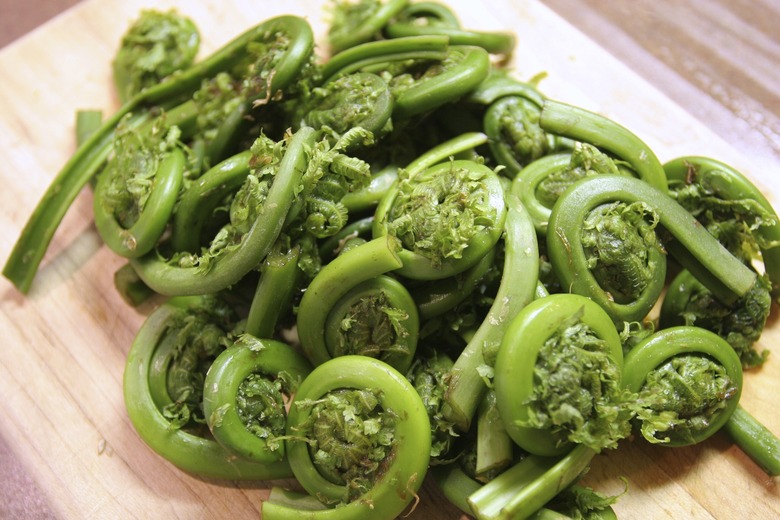Which Fiddlehead Ferns Are Edible?
Fiddlehead ferns can refer to a number of young, unfurled ferns, but ostrich ferns (Matteuccia struthiopteris) are the variety of ferns harvested and eaten. As part of a landscape design, however, ostrich ferns, hardy in U.S. Department of Agriculture zones 3 through 7, make for a pleasing green backdrop for perennial plants. Before picking fiddleheads in the wild, ensure you have permission to do so — that the ferns are not on private property and are not growing in a protected area, such as a nature preserve. Eat fiddleheads only in small quantities.
Identifying Fiddlehead Ferns
Although other ferns such as the lady fern (Athyrium filix-femina; USDA zones 3 through 9) and the bracken fern (Pteridium aquilinum; USDA zones 3 through 11) can also be harvested and eaten, only ostrich ferns produce true fiddlehead ferns.
Identify young ostrich ferns shoots by the U-shaped groove on the interior of the stalk and the papery brown covering at the curled portion of the fern. Ostrich ferns **grow at least 6 feet high,** while lady ferns and bracken ferns reach no more than 1 to 3 feet high. Ostrich ferns have five to nine fronds that grow in a rosette shape, creating a funnel.
- Fiddlehead ferns can refer to a number of young, unfurled ferns, but ostrich ferns (Matteuccia struthiopteris) are the variety of ferns harvested and eaten.
Finding and Growing Fiddleheads
Although you can grow ostrich ferns for fiddleheads, some people forage for these ferns, going out in early spring to look for the young, green shoots. Ostrich ferns grow in groups of three to 12 fronds — or fiddleheads when young — and thrive in shady, cool environments. Look for them from late April to early June along streams, brooks and rivers.
Home-grown ostrich ferns ensure an easy-to-find harvest each spring. Situate the ferns in an area that receives dappled sunlight and is consistently damp and moist. Ostrich ferns grow best in protected areas that do not receive much wind and have rich, moist soil. Start ferns in containers and space them 18 to 24 inches apart. Before planting, mix in compost, in a ratio of roughly 1 to 3 parts compost to soil, to a depth of 2 feet. Do not fertilize ferns, and water regularly, several times a week, to ensure the soil stays consistently damp when touched.
- Although you can grow ostrich ferns for fiddleheads, some people forage for these ferns, going out in early spring to look for the young, green shoots.
- Ostrich ferns grow in groups of three to 12 fronds — or fiddleheads when young — and thrive in shady, cool environments.
Harvesting Fiddleheads
Harvest fiddleheads for eating when they are still very young — when they grow to 1 to 2 inches above ground. As they mature, the ferns become bitter and fully mature ostrich ferns — unfurled — should not be eaten. Harvest ostrich ferns until they grow more than 20 inches high, although the bigger they are, the more pronounced their taste becomes.
Cut the ferns at the base of the plant, near where the U-shaped stalk hits the ground. Sterilize cutting tools — knife or scissors — beforehand, and wear gloves if necessary to protect fingers from accidental scrapes. The stems of younger ferns can sometimes also be broken by hand. **Harvest no more than two-thirds of the fiddleheads from a plant.**
- Harvest fiddleheads for eating when they are still very young — when they grow to 1 to 2 inches above ground.
Cleaning and Storage
Rinse fiddleheads in cold water to clean them, spraying and soaking to loosen the papery brown coating. Gently rub the fiddleheads to remove the papery coating. Rinse off any dirt caught in the U-shaped groove. Store fiddleheads in the refrigerator, in a plastic bag, for up to two weeks after harvest. You may also blanche and freeze cleaned fiddleheads for future use. **All fiddleheads must be steamed or boiled before eating.** For sauteed or stir-fried fiddleheads, steam or boil the ferns first.
- Rinse fiddleheads in cold water to clean them, spraying and soaking to loosen the papery brown coating.
- All fiddleheads must be steamed or boiled before eating.
- **
